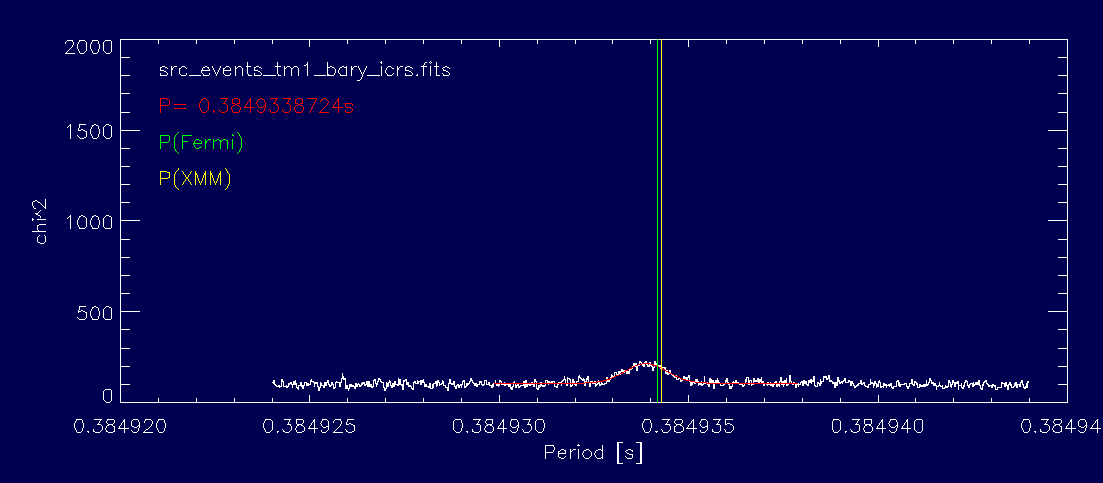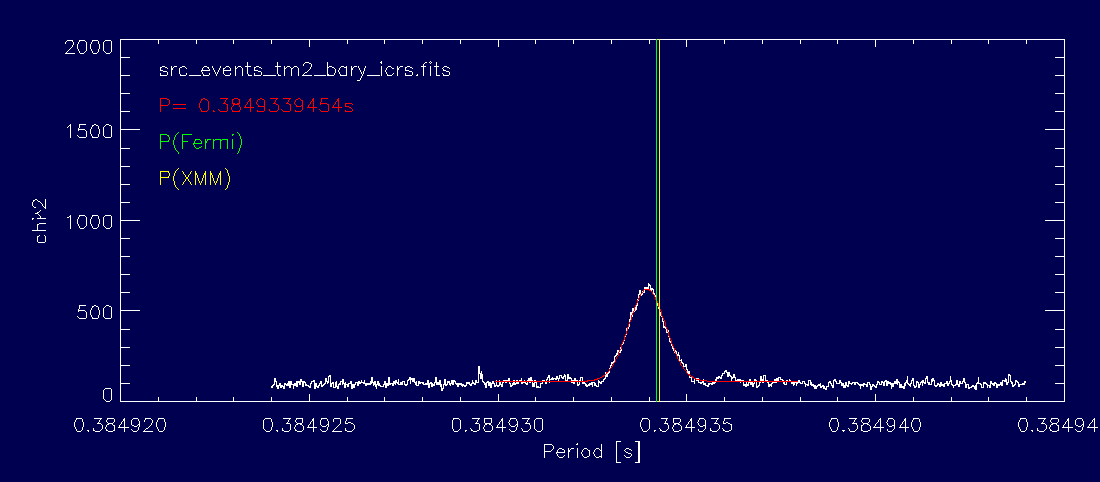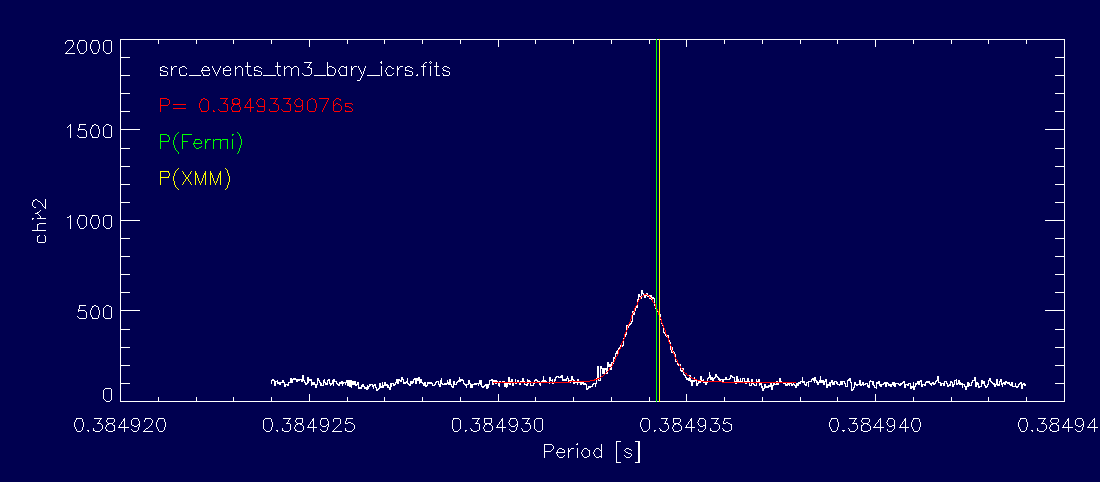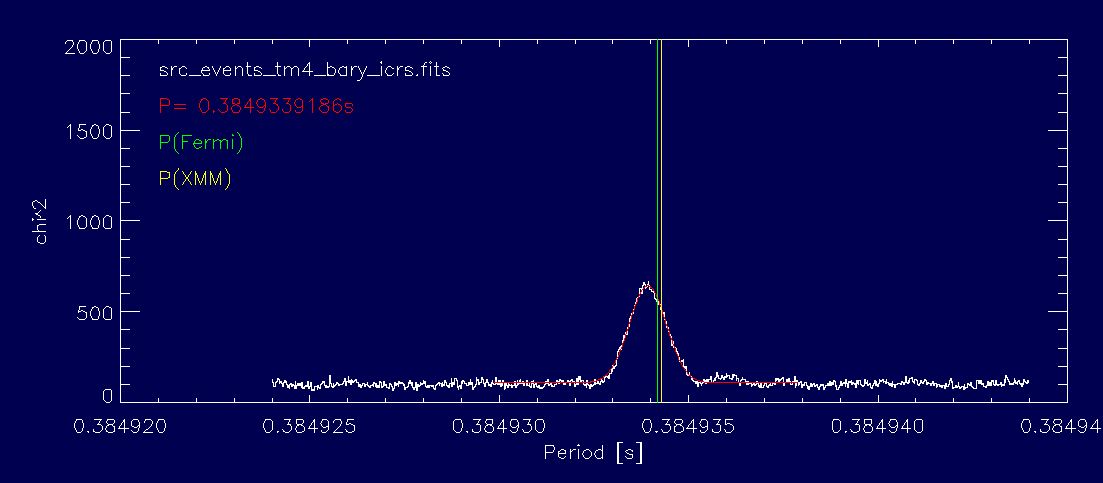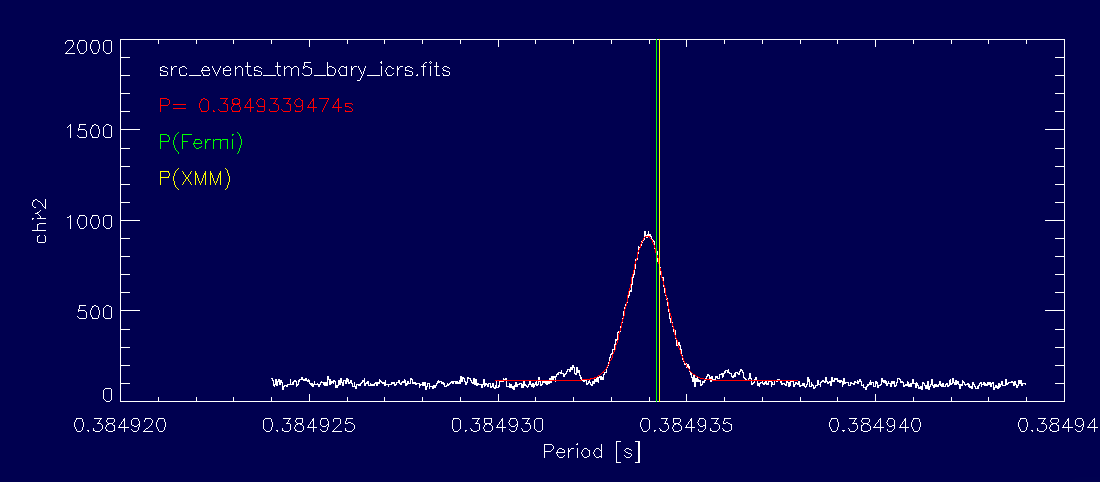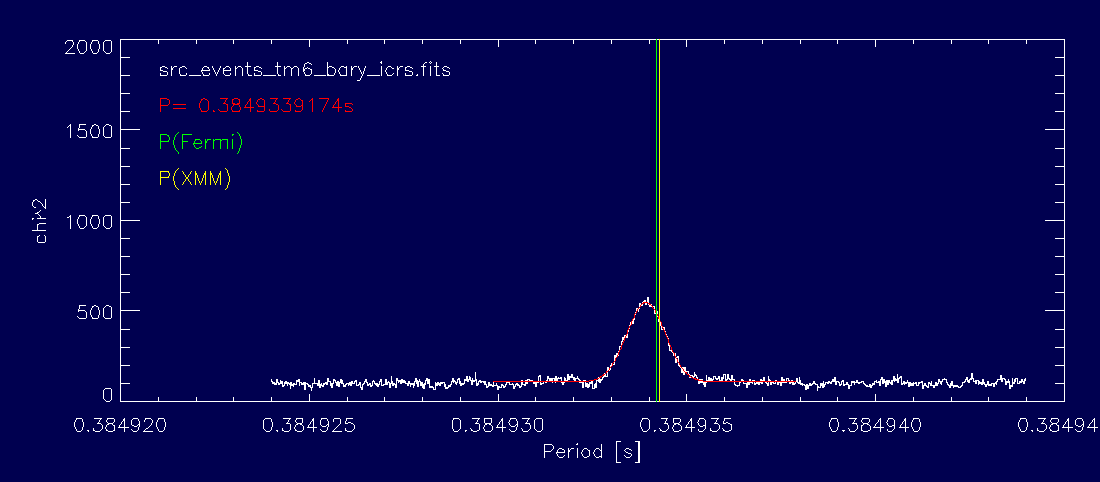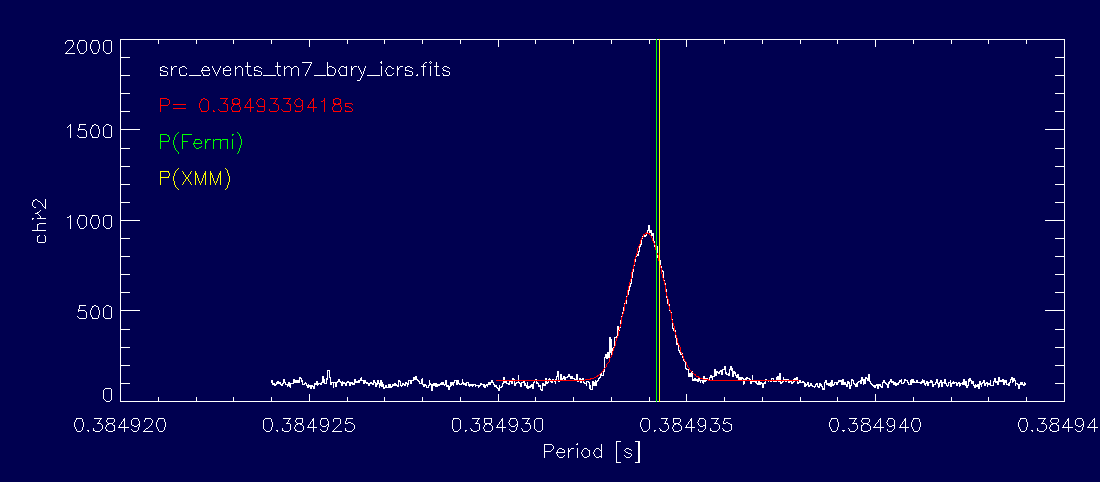|
Size: 6075
Comment:
|
← Revision 73 as of 2021-12-14 21:00:23 ⇥
Size: 9455
Comment:
|
| Deletions are marked like this. | Additions are marked like this. |
| Line 1: | Line 1: |
| # acl EroCalibTemplate:read,write,revert MembersGroup:read SeniorMembersGroup:read | # acl EroCalibTemplate:read,write,revert MembersGroup:read SeniorMembersGroup:read EroIkiCalGroup:read,write,revert |
| Line 5: | Line 5: |
| G. Lamer with contributions by J. Kurpas, A. Schwope, and I. Traulsen (AIP). | G. Lamer with contributions by J. Kurpas, A. Schwope, I. Traulsen (AIP), and V. Doroshenko (IAAT) |
| Line 9: | Line 9: |
| However, it turned out that the data are incomplete during an electronics issue and | However, it turned out that the data of TM1 are somehow corrupt for an electronics issue and |
| Line 11: | Line 11: |
| A simultaneous observation of PSR 0656+14 was carried with XMM-Newton. | A simultaneous observation of PSR 0656+14 was carried out with XMM-Newton. The combination of pulsar signal with XMM-observation shall serve as external reference source to support calibration of eROSITA timings. |
| Line 14: | Line 14: |
| at radio frequencies, in X-rays and Gamma-rays. '''Barycentric correction:''' |
at radio frequencies, in X-rays, and Gamma-rays. The reference period used by us is based on Ray et al. (2011) and accessible [[https://www.slac.stanford.edu/~kerrm/fermi_pulsar_timing/|here]] At the time of the simultaneous eROSITA/XMM-Newton observation the expected period of the pulsar is 0.38493417645(3) sec, where the number in parentheses indicates the uncertainty in the last digit. |
| Line 19: | Line 19: |
| In order to analyse the pulsations of PSR 0656+14 a barycentric correction of the event tinmes needs | === Barycentric correction: === In order to analyse the pulsations of PSR 0656+14 a barycentric correction of the event times needs |
| Line 21: | Line 24: |
| the HEASOFT ''barycen'' task can be used. We have converted the orbit file ''omnia_orbit_october_2019.log'' into a FITS file with the format required by ''barycen''. |
the [[ https://heasarc.gsfc.nasa.gov/lheasoft/ftools/headas/barycen.html|HEASOFT ''barycen'']] task can be used. We have converted the orbit file ''omnia_orbit_october_2019.log'', provided by NPOL, into a FITS file with the format required by ''barycen''. |
| Line 29: | Line 31: |
| Line 30: | Line 33: |
| Line 33: | Line 37: |
| changed to "GTI" before calling ''barycen'' and then changed back to its original name. | changed to "GTI" before calling ''barycen'' and then changed back to its original name. |
| Line 37: | Line 42: |
| barycen infile="ICRS" keyword TIMEREF="LOCAL" keyword TIMESYS="TT" Since ''barycen'' only recognizes the extension name "GTI", the name of the GTI extension needs to changed to "GTI" before calling ''barycen'' and then changed back to its original name. The ''barycen'' task was called with the following command line: barycen infile=src_events_tm2.fits \ <<BR>> outfile=src_events_tm2_bary_icrs.fits \ <<BR>> rbfile=orbit_october_2019_scc.fits \ <<BR>> ra=104.9507468 \ <<BR>> dec=14.23963084 \ <<BR>> orbext="ORBIT" \ <<BR>> orbform="COMPONENTS" \ <<BR>> orbcol="X,Y,Z,VX,VY,VY,VZ" \ <<BR>> startcol="START" \ <<BR>> stopcol="STOP" \ <<BR>> refframe="ICRS" \ <<BR>> orbinterp="WEIGHTED" \ <<BR>> timecol="TIME" \ <<BR>> chatter=3 \ <<BR>> clobber=yes \ <<BR>> debug=yes <<BR>> |
barycen infile=src_events_tm2.fits \<<BR>> outfile=src_events_tm2_bary_icrs.fits \<<BR>> orbfile=orbit_october_2019_scc.fits \<<BR>> ra=104.9507468 \<<BR>> dec=14.23963084 \<<BR>> orbext="ORBIT" \<<BR>> orbform="COMPONENTS" \<<BR>> orbcol="X,Y,Z,VX,VY,VZ" \<<BR>> startcol="START" \<<BR>> stopcol="STOP" \<<BR>> refframe="ICRS" \<<BR>> orbinterp="WEIGHTED" \<<BR>> timecol="TIME" \<<BR>> chatter=3 \<<BR>> clobber=yes \<<BR>> debug=yes<<BR>> |
| Line 64: | Line 60: |
| Example bash script: [[attachment:run_bary.sh|run_bary.sh]] | Example bash script: [[attachment:run_barycen.sh|run_barycen.sh]] |
| Line 67: | Line 63: |
| fit to the chi^2 peak near the published pulse period. | fitted to the chi^2 peak near the published pulse period. |
| Line 71: | Line 67: |
| Update 20.02.2020 by VictorDoroshenko: An alternative python script for correction was prepared by VictorDoroshenko [[attachment:barycor.py.zip]]. This was actually inspired by barycen code, although is not a direct port of that and uses other libs/ephemerides, i.e. more or less independent. Using this correction the timing analysis was carried out. The main issue that there appears to be an offset of ~7s between corrected times as per barycen and python script (see i.e. [[attachment:diff_barycen_py.png]] for TM5 events). This is likely caused by heasarc barycen as the first 45 entries are corrected to meaningless values (on my machine at least). The 46th value from file corrected by barycen corresponds to first value from the raw event file, so an offset of ~7s is introduced. If we account for this shift, the difference between the two scripts becomes less than 2e-3s. For periodicity search Z-statistics on unbinded events was used but here results are broadly comparable with that reported before. |
|
| Line 72: | Line 73: |
| '''Results:''' | |
| Line 74: | Line 74: |
| eROSITA periods before and after barycentric correction: | === Results: === eROSITA periods before and after barycentric correction (see [[https://wiki.mpe.mpg.de/eRosita/timing#Figures_periods|Figures periods ]] below) |
| Line 86: | Line 89: |
| ||XMM || - || 0.38493427 || ||Ref*|| - || 0.3849341856 || ||XMM-Ref || || 8.94070E-08 || ||eRO-Ref || || -2.68221E-07 || ||eRO-XMM || || -3.57628e-07 || |
||XMM || - || 0.38493427 || ||Ref*|| - || 0.384934176454 || ||XMM-Ref || || 9.9888E-08 || ||eRO-Ref || || -2.57740E-07 || ||eRO-XMM || || -3.57628E-07 || |
| Line 99: | Line 102: |
| (P_ero-P_fermi)/P_fermi = -6.970E-7 | (P_ero-P_fermi)/P_fermi = -6.4025E-7 |
| Line 103: | Line 106: |
| * SRG clock drift: no calibration data are currently available for October 2019. However, the clock drift is estimated to be of the order 10 ms/day, i.e. relative drift of 1.15741e-07, which is not sufficient to account for the observed discrepancy. | * SRG clock drift: no calibration data are currently available for October 2019. However, the clock drift is estimated to be of the order 10 ms/day corresponding to a relative drift of 1.15741e-07. This is not sufficient to account for the observed discrepancy. |
| Line 109: | Line 112: |
| ---------------------------------------- (begin insert Doroshenko) |
|
| Line 110: | Line 115: |
| '''Time lags''' | === Results with alternative correction: === |
| Line 112: | Line 117: |
| When comparing the folded pulse profiles the following offsets in event times were detected. | For events between 0.3-2 keV within 40 arcsec from source position barycentric correction using the attached python script and orbit file was performed. After that, a search with Z-statistics was conducted. Two harmonics were sufficient to describe the signal. The period search was done for individual modules as well as for concatenated event list. The results are reported below and compared with barycen results presented above in [[attachment:periods_comparison_vd_vs_lamer.pdf]]. In general, there is a good agreement between two independent attempts to reduce eRosita data at least in context of observed period of the source. || Camera || P before correction [s] || P after bary correction [s] || ||TM1 || 0.3848959710380255 || 0.3849341592690358 || ||TM2 || 0.38489571065513584 || 0.38493393442207546 || ||TM3 || 0.38489566656028723 || 0.38493391900328405 || ||TM4 || 0.38489573178127434 || 0.3849339257237277 || ||TM5 || 0.3848956642017522 || 0.3849339579434112 || ||TM6 || 0.3848956385909294 || 0.384933886442975 || ||TM7 || 0.38489571824733776 || 0.384933980446571 || ||eRO(TM2-7)|| 0.38489570294 || 0.38493393(2) || ||eRO-Ref || || -2.43687138e-07 || ||eRO-XMM || || -3.37233138e-07 || (end insert Doroshenko) ---------------------------------------- === Time lags === We calculated folded pulse profiles with start time T0_scc=6.243790548902941D8 and P=0.38493392969366 (see [[https://wiki.mpe.mpg.de/eRosita/timing#Figures_pulse_profiles|Figures pulse profiles ]] below) When comparing the folded pulse profiles the following offsets in event times were detected (assuming that the phase shifts are caused by the known +- 1sec time jumps): |
| Line 124: | Line 155: |
| The offsets on 15-Nov were determined using positional offsets measured in the eFEDS scans. This indicates that time jumps have occurred in cameras TM1,TM4,TM5, and TM6 between 14-Oct and 15-Nov. |
|
| Line 125: | Line 158: |
| This results that time jumps have occured in cameras TM1,TM4,TM5, and TM6 between 14-Oct and 15-Nov. | ---------------------------------------- |
| Line 128: | Line 161: |
'''Figures:''' |
=== Figures periods === |
| Line 149: | Line 180: |
| ---------------------------------------- | |
| Line 150: | Line 182: |
| Folded pulse profiles without correction for time lags: | === Figures pulse profiles === Folded pulse profiles with barycenter corrected data TM1-TM7: |
| Line 154: | Line 188: |
| Folded pulse profiles with the correction time=time-1s for cameras TM1,TM3,TM4: | Folded pulse profiles with additional correction TIME=TIME-1s for cameras TM1,TM3,TM4: |
PSR 0656+14 timing analysis
G. Lamer with contributions by J. Kurpas, A. Schwope, I. Traulsen (AIP), and V. Doroshenko (IAAT)
The pulsar PSR 0656+14 was observed on 14/15-Oct-2019 for 115 ksec. The cameras of all telescopes TM1-TM7 observed with the filter wheel in "FILTER" position. However, it turned out that the data of TM1 are somehow corrupt for an electronics issue and are only of limited use for this analysis. A simultaneous observation of PSR 0656+14 was carried out with XMM-Newton. The combination of pulsar signal with XMM-observation shall serve as external reference source to support calibration of eROSITA timings.
The pulsations of PSR 0656+14 have a period of P=0.385 sec and have beeen observed at radio frequencies, in X-rays, and Gamma-rays. The reference period used by us is based on Ray et al. (2011) and accessible here At the time of the simultaneous eROSITA/XMM-Newton observation the expected period of the pulsar is 0.38493417645(3) sec, where the number in parentheses indicates the uncertainty in the last digit.
Barycentric correction:
In order to analyse the pulsations of PSR 0656+14 a barycentric correction of the event times needs to be applied. Until the eSASS task with this functionality is implemented, a workaround using the HEASOFT ''barycen'' task can be used. We have converted the orbit file omnia_orbit_october_2019.log, provided by NPOL, into a FITS file with the format required by barycen.
October 2019 orbit file: orbit_october_2019_scc.fits
Also the headers of the event files to be corrected need to be modified:
keyword RADECSYS="ICRS"
keyword TIMEREF="LOCAL"
keyword TIMESYS="TT"
Since barycen only recognizes the extension name "GTI", the name of the GTI extension needs to changed to "GTI" before calling barycen and then changed back to its original name.
The barycen task was called with the following command line:
barycen infile=src_events_tm2.fits \
outfile=src_events_tm2_bary_icrs.fits \
orbfile=orbit_october_2019_scc.fits \
ra=104.9507468 \
dec=14.23963084 \
orbext="ORBIT" \
orbform="COMPONENTS" \
orbcol="X,Y,Z,VX,VY,VZ" \
startcol="START" \
stopcol="STOP" \
refframe="ICRS" \
orbinterp="WEIGHTED" \
timecol="TIME" \
chatter=3 \
clobber=yes \
debug=yes
Example bash script: run_barycen.sh
Before and after barycentric correction a chi^2 period search was applied to the data and a Gaussian was fitted to the chi^2 peak near the published pulse period. The XMM-Newton data were reduced and barycenter corrected using the XMMSAS package and the pulse period was determined, details will be described elsewhere.
Update 20.02.2020 by VictorDoroshenko: An alternative python script for correction was prepared by VictorDoroshenko barycor.py.zip. This was actually inspired by barycen code, although is not a direct port of that and uses other libs/ephemerides, i.e. more or less independent. Using this correction the timing analysis was carried out. The main issue that there appears to be an offset of ~7s between corrected times as per barycen and python script (see i.e. diff_barycen_py.png for TM5 events). This is likely caused by heasarc barycen as the first 45 entries are corrected to meaningless values (on my machine at least). The 46th value from file corrected by barycen corresponds to first value from the raw event file, so an offset of ~7s is introduced. If we account for this shift, the difference between the two scripts becomes less than 2e-3s. For periodicity search Z-statistics on unbinded events was used but here results are broadly comparable with that reported before.
Results:
eROSITA periods before and after barycentric correction (see Figures periods below)
Camera |
P before correction [s] |
P after bary correction [s] |
TM1 |
0.38489567005 |
0.384933872 |
TM2 |
0.38489572213 |
0.384933945 |
TM3 |
0.38489567927 |
0.384933908 |
TM4 |
0.38489568964 |
0.384933919 |
TM5 |
0.38489572062 |
0.384933948 |
TM6 |
0.38489568900 |
0.384933918 |
TM7 |
0.38489571696 |
0.384933942 |
eRO(TM2-7) |
0.38489570294 |
0.384933930 |
SD(TM2-7) |
|
1.63234E-08 |
XMM |
- |
0.38493427 |
Ref* |
- |
0.384934176454 |
XMM-Ref |
|
9.9888E-08 |
eRO-Ref |
|
-2.57740E-07 |
eRO-XMM |
|
-3.57628E-07 |
* Based on Fermi LAT data (Ray et al. 2011), corrected for spin down to 14-Oct-2019
Assuming the standard deviation of the TM2-TM7 period measurements as error estimate, the discrepancy between the eROSITA measuments versus the reference by XMM-Newton or Fermi is clearly significant. The relative discrepancy of the eROSITA measurement vs. the Fermi reference is
(P_ero-P_fermi)/P_fermi = -6.4025E-7
The following sources of errors need to be considered:
- SRG clock drift: no calibration data are currently available for October 2019. However, the clock drift is estimated to be of the order 10 ms/day corresponding to a relative drift of 1.15741e-07. This is not sufficient to account for the observed discrepancy.
- Inaccuracy of the orbit file, the observed discrepancy would correspond to a velocity difference of ~200 m/s
Other inaccuracies in the barycentric correction (barycen task, wrong assumptions on time/reference frames etc.), suggestions or comparisons with other codes are welcome.
(begin insert Doroshenko)
Results with alternative correction:
For events between 0.3-2 keV within 40 arcsec from source position barycentric correction using the attached python script and orbit file was performed. After that, a search with Z-statistics was conducted. Two harmonics were sufficient to describe the signal. The period search was done for individual modules as well as for concatenated event list. The results are reported below and compared with barycen results presented above in periods_comparison_vd_vs_lamer.pdf. In general, there is a good agreement between two independent attempts to reduce eRosita data at least in context of observed period of the source.
Camera |
P before correction [s] |
P after bary correction [s] |
TM1 |
0.3848959710380255 |
0.3849341592690358 |
TM2 |
0.38489571065513584 |
0.38493393442207546 |
TM3 |
0.38489566656028723 |
0.38493391900328405 |
TM4 |
0.38489573178127434 |
0.3849339257237277 |
TM5 |
0.3848956642017522 |
0.3849339579434112 |
TM6 |
0.3848956385909294 |
0.384933886442975 |
TM7 |
0.38489571824733776 |
0.384933980446571 |
eRO(TM2-7) |
0.38489570294 |
0.38493393(2) |
eRO-Ref |
|
-2.43687138e-07 |
eRO-XMM |
|
-3.37233138e-07 |
(end insert Doroshenko)
Time lags
We calculated folded pulse profiles with start time T0_scc=6.243790548902941D8 and P=0.38493392969366 (see Figures pulse profiles below)
When comparing the folded pulse profiles the following offsets in event times were detected (assuming that the phase shifts are caused by the known +- 1sec time jumps):
Camera |
Time offset [s] 14-Oct-2019 |
Time offset [s] 15-Nov-2019 |
TM1 |
0.0 |
1.0 |
TM2 |
1.0 |
1.0 |
TM3 |
0.0 |
0.0 |
TM4 |
0.0 |
1.0 |
TM5 |
1.0 |
0.0 |
TM6 |
1.0 |
0.0 |
TM7 |
1.0 |
1.0 |
The offsets on 15-Nov were determined using positional offsets measured in the eFEDS scans. This indicates that time jumps have occurred in cameras TM1,TM4,TM5, and TM6 between 14-Oct and 15-Nov.
Figures periods
Chi^2 vs. period for barycenter corrected eROSITA data:
Figures pulse profiles
Folded pulse profiles with barycenter corrected data TM1-TM7:
Folded pulse profiles with additional correction TIME=TIME-1s for cameras TM1,TM3,TM4:
